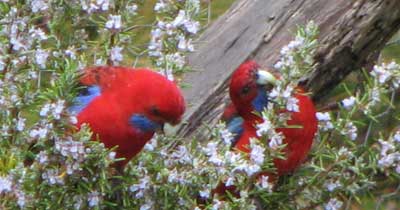
Woody narrow-leaved Mediterranean shrubs like rosemary are happy in drier and poorer soils, and grow well from cuttings.
Hence I have poked rosemary bushes into the least fertile places in my yard, such as the clay patches by the track.
And just look how they repay me! Pale blue blossoms absolutely festoon the branches in winter.

Bees love them. So, it seems, do the crimson rosellas, at least on this occasion.
I’m not sure what they would have been eating on the rosemary, but their richly-coloured plumage was such a contrast that they made the bushes appear snowy.
They have’t been back since, but then so many of the special sights here are only fleetingly fabulous.
Hi Keith,
That’s interesting! Maybe they were beak-sharpening?
Was the bush in flower then?
We live in an Eastern suburb of Melbourne in the foothills of the Dandenongs. We see many different types of birds in our garden – Rainbow lorikeets, crimson rosellas, king parrots, butcher birds, currawongs and magpies to name but a few. We have lived here for more than ten years and today was the first time we have seen young crimson rosellas in our rosemary bush in the front yard. they appear to be actually eating the rosemary twigs, not the blooms.
Dear DWG, thanks for reminding us how fabulous our rosies are. We are spoilt here in Australia with so many colourful parrots, although of course not all are found in each area. These crimson ones are my most common – but always a fresh delight.
Sharyn
Oh these crimson rosellas are just the most beautiful things I have ever seen. And against the rosemary plants it is just breathtaking.
So sorry we don’t have the rosella in my part of the world. Thanks for another enjoyable post from the natural world. Enjoy your spring!
DWG in USA